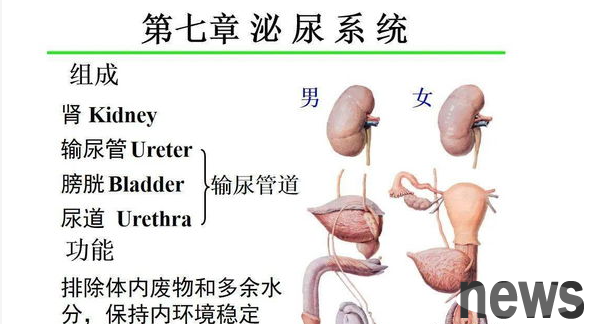Urlisia, also known as urinary tract stones, is a general term for kidney stones, ureteral stones, bladder stones and urethral stones. Clinically, it is characterized by difficulty in urination, pain in the obstructive area and hematuria. 【cause】The...
Urlisia, also known as urinary tract stones, is a general term for kidney stones, ureteral stones, bladder stones and urethral stones. Clinically, it is characterized by difficulty in urination, pain in the obstructive area and hematuria.

【cause】The causes of urinary stone formation are not fully understood. It is generally believed to be related to factors such as monotonous food or excessive mineral content, insufficient drinking water, mineral metabolism disorders, changes in urine pH, urinary tract infections and lesions.
Anatomy of the urinary system丨Detailed explanation of urinary system anatomy
Colloid and crystal equilibrium imbalance: In normal urine, there are crystal salts (phosphate, urate, oxalate, etc.) in various dissolved states and a certain amount of colloidal substances (mucin, nucleic acid, mucopolysaccharide, cystine, etc.), and they maintain a relative equilibrium state. Once this balance is out of order, that is, when the crystal exceeds the normal saturation concentration, or when the colloidal substances continuously lose the stable structure between molecules, salt precipitation and colloid precipitation will occur in the urine, which will then condense into stones.
Social metabolic disorders: such as hyperparathyroidism, excessive secretion of parathyroid hormones, etc., causing the metabolism of minerals in the body to be disordered, and excessive urinary calcium may occur, and factors such as excessive estrogen levels in the body can promote the formation of urinary stones.
Urchive tract lesions: Urinary tract lesions are an important condition for the formation of stones.
① When urinary tract infection, urinary tract inflammation can cause tissue necrosis. Coupled with the accumulation of inflammatory exudates and bacteria, it can form the core of the stone, and its outer periphery is surrounded by mineral salts and colloidal substances to form stones. In addition, many bacteria such as Staphylococcus, Proteobacteria, Salmonella, etc. can decompose urea into ammonia, making the urine alkaline, and easily cause precipitation of calcium phosphate, calcium carbonate, etc., which is conducive to the formation of urinary tract stones.
②When the urinary tract is obstructed, it can cause hydronephrosis, causing urine to retention, prone to infection and crystal precipitation, and form stones.
③When foreign objects (suppets, catheters, blood clots, bacteria, shedded cells, etc.) exist in the urinary tract, it can become the core of the stone, and crystal salts in the urine settle on their surface to form stones.
Uristones are mainly formed in the kidneys (renal tubules, calyx, renal pelvis), and later move to the bladder and continue to enlarge in the bladder. Therefore, it is believed that the bladder is the most common place for urinary stones in dogs and cats. Urine lilies in the renal tubules are mostly fixed, but stones in the renal pelvis or bladder can move, and some may blockage when they move to the ureter and urethra. The blocked area of the stone stimulates the urinary tract mucosa, causing local mucosa damage, inflammation, bleeding, causing spasms and contraction of the smooth muscle of the urinary tract, and causing renal abdominal pain. Due to urinary tract obstruction, urinary stasis, cystolic fluid accumulates, resulting in bladder paralysis and even rupture.
【Symptoms】The clinical symptoms of urolithia vary from its obstruction site, size, and degree of damage to tissue.
Kidney stones: Mostly located in the renal pelvis. There are often no obvious symptoms in the early stage of kidney stone formation, and then there are symptoms of pyelitis, such as hematuria, tenderness in the kidney area, slow walking, strong gait and tenseness. In severe cases, hydronephrosis may form.
Ureterate stones: acute abdominal pain, vomiting, dogs and cats are unwilling to walk, showing pain, walking on the back, and palpation of the abdominal pain. When the ureter is unilateral or incompletely obstructed, hematuria, pyuria and proteinuria can be seen; if the bilateral ureter is completely obstructed at the same time, anuria enters the bladder, showing anuria or urinary occlusion, which often leads to pyelonephritis.
Bladder stones: Sick dogs and cats have difficulty urinating, hematuria and frequent urination, but the amount of excretion is small each time. Increased bladder sensitivity. When the stone is located on the neck of the bladder, it can show dysfunction and pain. Larger stones can often be touched when palpating.
Urethral stones: Mostly occur in male dogs and cats. When urethral insufficiency is blocked, urination is painful, urine flows out in a drip or intermittent manner, and sometimes urination is accompanied by blood. When the urethra is completely blocked, urinary occlusion and renal abdominal pain will occur. The bladder is extremely full, and sick dogs and cats are constantly working hard, but the urine is not excreted. Long-term time can cause bladder rupture or uremia.

【Diagnosis and Differential Diagnosis】
The diagnosis can be made based on clinical symptoms, urethral exploration and X-ray examination results. Some bladder stones are also accompanied by fat brother polyps or bladder tumors.
The common urinary stones in dogs and cats are as follows:
(1) Phosphate urinary stones: white or off-white, rapidly forming, can form antler-like stones, which often occur in alkaline mucus. X-ray development is lighter.
(2) Oxalate urinary stones: brown, rough and thorny on the surface, hard texture, easy to damage the urinary tract and cause hematuria, and occurs in alkaline urine. X-rays are characterized by deeper markings in urinary stones, mulberry-shaped, needle-shaped edges, and radiating outward.
(3) Urate urite: light yellow, smooth surface, hard texture, and often occurs in acidic urine. X-ray development is lighter.
(4) Cystine urolithiasis: The surface is smooth and can pass through X-rays, which is not easy to develop on X-rays, so it is called "light-transmissive stones" and occurs in acidic urine.
(5) Carbonate urite: white, crispy texture, and occurs in alkaline urine.
【Treatment】
The treatment principle is mainly based on excluding stones and supplemented by symptomatic treatment.
Dietary and drug treatment: In cases with incomplete obstruction or mild condition, foods with low minerals and rich in vitamin A are given, combined with Chinese medicine Pai Shi Tang and a large amount of clean water are given, diuretics, etc., to dilute urine and increase urination volume, and rinse the urinary tract so that small stones can be excreted with urine. For phosphate, oxalate and carbonate stones, they can be administered to acidic foods or acid preparations (such as zinc chloride, etc.) to acidify the urine to promote the dissolution of the stones and the improvement of the condition. For stones with urate and cystine, sodium bicarbonate should be taken to alkalize the urine, which can also prevent the formation of stones and promote the dissolution of stones. In addition, for urate stones, you can also take isopurinol 4 mg/kg daily to prevent urate from coagulation.. For cystine stones, D-penicillamine can be used for 15-30 mg/kg daily, making it a soluble cystine complex and excreted from the urine.
Surgery treatment: When large stones are accompanied by urinary tract obstruction, urethrology or cystectomy must be performed in time to remove the stones. If there is a bladder polyps or bladder tumor, it must be removed simultaneously. If there are fewer and smaller stones, ultrasonic gravel can be used.